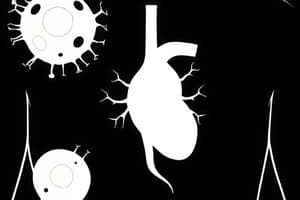Podcast
Questions and Answers
Which term refers to the replacement of one cell type with another?
Which term refers to the replacement of one cell type with another?
- Dysplasia
- Atrophy
- Hyperplasia
- Metaplasia (correct)
What can cause isotonic fluid excess?
What can cause isotonic fluid excess?
- Inflammatory reactions
- Heart failure (correct)
- Increased capillary pressure
- Venous obstruction
Which electrolyte imbalance can occur due to excessive excretion?
Which electrolyte imbalance can occur due to excessive excretion?
- Sodium
- Calcium
- Phosphates
- Potassium (correct)
What is a symptom of edema?
What is a symptom of edema?
What characterizes isotonic fluid deficits?
What characterizes isotonic fluid deficits?
Which condition can result from disturbances in acid-base balance?
Which condition can result from disturbances in acid-base balance?
Study Notes
- Pathophysiology is the study of how the body's functioning is altered in the presence of disease, leading to changes in cell structure and function.
- Cellular adaptations include atrophy (cell size decrease), hypertrophy (cell size increase), hyperplasia (increase in cell number), dysplasia (alteration in cell organization), and metaplasia (replacement of one cell type with another).
- Fluid balance disturbances can disrupt homeostasis, leading to various disease processes, with causes ranging from excessive input or output of fluids.
- Edema, excess fluid trapped in the body, can be caused by factors like increased capillary pressure, venous obstruction, and inflammatory reactions.
- Symptoms of edema can include fluid in the lungs, pedal edema (swelling of feet), and jugular venous distention (JVD).
- Isotonic fluid deficits involve proportional losses of sodium and water, while isotonic fluid excess involves proportional increases, commonly seen in conditions like kidney and heart failure.
- Disturbances in electrolyte balance like sodium, potassium, calcium, phosphates, and magnesium can occur due to various factors such as dietary intake, renal loss, or excessive excretion. Acid-base balance disruptions can be respiratory or metabolic in nature, leading to conditions like acidosis or alkalosis.
Studying That Suits You
Use AI to generate personalized quizzes and flashcards to suit your learning preferences.
Description
Explore the alterations in cell structure and function due to disease, including cellular adaptations like atrophy, hypertrophy, hyperplasia, dysplasia, and metaplasia. Learn about fluid balance disturbances, causes of edema, and disruptions in electrolyte and acid-base balance.




